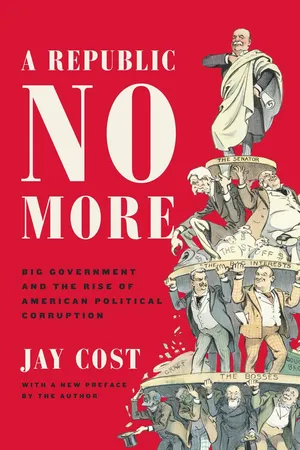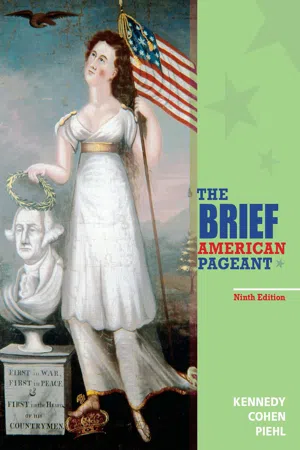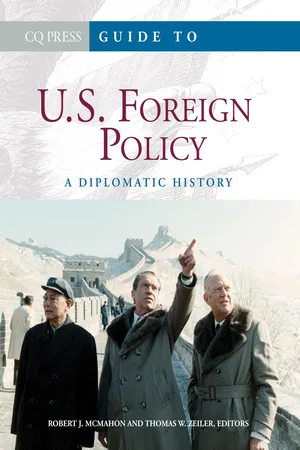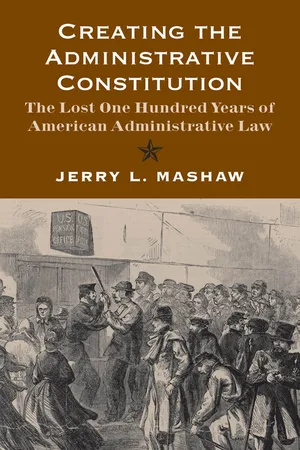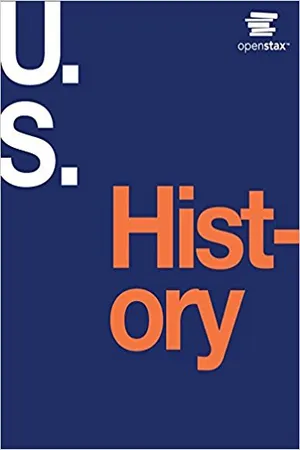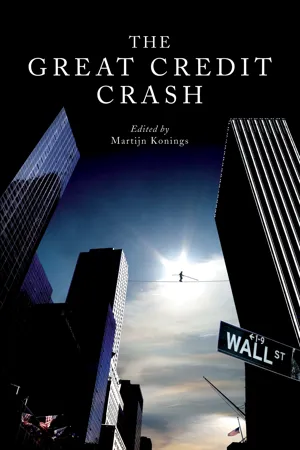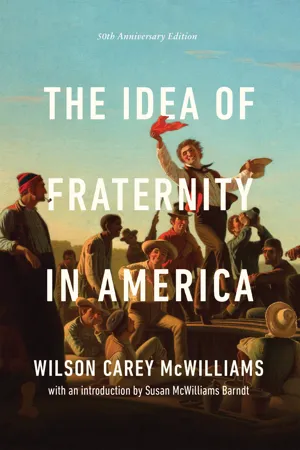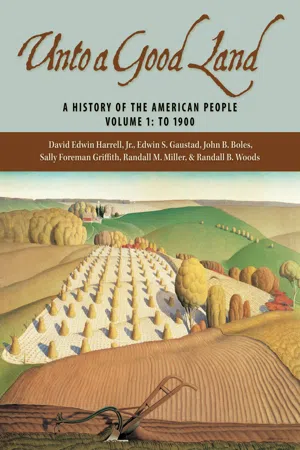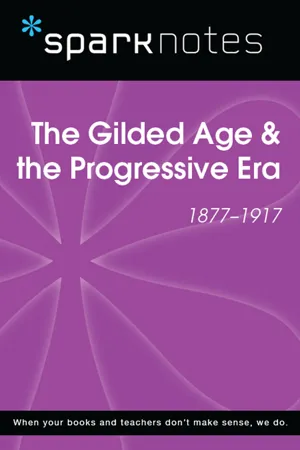History
Gilded Age Politics
Gilded Age politics refers to the political landscape in the United States during the late 19th century, characterized by widespread corruption, corporate influence, and a lack of government regulation. Political machines, such as Tammany Hall in New York City, wielded significant power, and there was a growing divide between the wealthy industrialists and the working class. This era saw the rise of influential political figures like Boss Tweed and the implementation of patronage systems.
Written by Perlego with AI-assistance
Related key terms
1 of 5
11 Key excerpts on "Gilded Age Politics"
- Gregory Feldmeth, Christine Custred, Christine Custred(Authors)
- 2015(Publication Date)
- Research & Education Association(Publisher)
Chapter 8 Industrialism and the Gilded Age (1865–1898)The period between the end of the Civil War and the beginning of the 20th century is known as the Gilded Age. Mark Twain first used the term “Gilded Age” to describe the years after the Civil War. He saw rampant greed, materialism, and corruption dominating American political and social life and viewed the outward appearance of prosperity and gaiety as being nothing more than a thin coating of gold on a fundamentally flawed society.Politics of the Period, 1877–1882The presidencies of Abraham Lincoln (1861–1865) and Theodore Roosevelt (1901–1909) mark the boundaries of half a century of relatively weak executive leadership, and legislative domination by Congress and the Republican Party.The Compromise of 1877With Southern Democratic acceptance of Rutherford B. Hayes’s Republican presidency, the last remaining Union troops were withdrawn from the Old Confederacy (South Carolina, Florida, Louisiana), and the country was at last reunified as a modern nation-state led by corporate and industrial interests. The Hayes election arrangement also marked the government’s abandonment of its earlier vague commitment to African American equality.Republican Factions“Stalwarts” led by New York Senator Roscoe Conkling favored the old spoils system of political patronage. “Half-Breeds” headed by Maine Senator James G. Blaine pushed for civil service reform and merit appointments to government posts.Election of 1880In the 1880 presidential election, James A. Garfield of Ohio, a Half-Breed, and his vice presidential running mate, Chester A. Arthur of New York, a Stalwart, defeated the Democratic candidate, General Winfield S. Hancock of Pennsylvania and former Indiana congressman William English. Tragically, the Garfield administration was brief, as the president was assassinated in 1881 by a disturbed office-seeker, Charles Guiteau. Though lacking much executive experience, the stalwart Arthur had the courage to endorse reform of the political spoils system by supporting passage of the Pendleton Act (1883), which established open competitive examinations for civil service positions.- eBook - ePub
A Republic No More
Big Government and the Rise of American Political Corruption
- Jay Cost(Author)
- 2016(Publication Date)
- Encounter Books(Publisher)
5 “The King of Frauds” Business and Politics in the Gilded AgeT HE GILDED AGE after the Civil War is usually remembered as an anomalous era of unprecedented corruption. Morals fell to shambles, avaricious politicians rose up, and there was an epic collapse in public ethics. None of this had ever been seen before, so the thinking goes.In an important sense that is most definitely the case, for the country had never seen corruption quite as bad as existed in the two or three generations following the Civil War. But in another sense, that is not true. As we saw in the last chapter with the spoils system, while the level of patronage-based corruption may have increased, there was no qualitative difference between the Gilded Age and the Jacksonian period. Instead, the spoils system was perfected, in a perverse sense of the word. Politicians became more adept at using government jobs to grow and maintain political organizations, and in turn to bilk the public more efficiently than Andrew Jackson’s cronies ever did.The story is the same when we consider the other main theme of Gilded Age corruption, currying favor with big business. In Chapter One, we saw corruption spring up over governmental efforts to support the economy, in the case of the Bank of the United States. A former Treasury Department official used insider information to game the system, members of Congress were on the take, and even the stately Hamilton allowed details of his plans to become known to speculators. As we saw in Chapter Two, these trends continued through the Jeffersonian and Jacksonian eras; as government did more to grow the economy, business-oriented corruption similarly grew. This “progress” continued apace in the Gilded Age. It was not that this form of corruption—of public officials and businessmen conniving for private goals—was unheard of prior to the 1880s. Far from it. Instead, as rapid economic growth depended more and more on governmental policies, the incentives and opportunities for businessmen to involve themselves in politics became greater. Meanwhile, with federal jobs no longer an available patronage outlet, and the costs of campaigns ever-growing, politicians sought new sources of funds to manage their political empires. Thus, new forms of corruption did not emerge; instead, old forms proliferated and became more sophisticated, organized, and even accepted. - eBook - PDF
A People and a Nation
A History of the United States
- Jane Kamensky, Carol Sheriff, David W. Blight, Howard Chudacoff(Authors)
- 2017(Publication Date)
- Cengage Learning EMEA(Publisher)
Due to electronic rights, some third party content may be suppressed from the eBook and/or eChapter(s). Editorial review has deemed that any suppressed content does not materially affect the overall learning experience. Cengage Learning reserves the right to remove additional content at any time if subsequent rights restrictions require it. The Spectacle of Gilded Age Politics During the Gilded Age, political events, especially presidential elections, provided opportunity for elaborate spectacle, and politicians occupied the limelight as major celebrities. A presidential campaign functioned as a public festival at a time when mass entertainments such as movies and sports did not exist to offer people outlets for their emotions. Campaigns often included parades, fireworks, and marching bands. This image, an artist’s rendering, presents evidence of how people of the era might have expressed themselves politically. CRITICAL THINKING ■ How did Gilded Age presidents use executive power to influence the development of legislation? ■ What similarities to modern-day campaign events and symbols does this image represent? In what ways is it different? ■ Did politics and campaigning in the Gilded Age play a different role in the nation’s culture than they do at present? Library of Congress, Prints & Photographs Division, Reproduction number LC-USZC4-5605 (color film copy transparency)LC-USZCN4-200 (color film copy neg.) Though business interests generally prevailed in the Gilded Age, various interest groups supported regulation. In this cartoon, a businessman is being tossed around by a “Silverite” (the man in the red shirt who is supporting free silver), a Republican (the bearded man in the frock coat), a Populist (the man in overalls), and a Democrat (the man in the checked suit). racial violence. He tried to overhaul the spoils system by appointing civil service reformer Carl Schurz to his cabinet and by battling New York’s patronage king, Senator Conk- ling. - eBook - PDF
The Brief American Pageant
A History of the Republic
- David Kennedy, Lizabeth Cohen, Mel Piehl, , David Kennedy, Lizabeth Cohen, Mel Piehl(Authors)
- 2015(Publication Date)
- Cengage Learning EMEA(Publisher)
Political Paralysis in the Gilded Age 371 Pallid Politics in the Gilded Age The political seesaw was delicately balanced throughout most of the Gilded Age (a sarcas-tic name given to the three-decade-long post–Civil War era by Mark Twain in 1873). Even a slight nudge could tip the teeter-totter to the advantage of the opposition party. Every presidential election was a squeaker, and the majority party in the House of Representa-tives switched six times in the eleven sessions between 1869 and 1891. Wobbling in such shaky equilibrium, politicians tiptoed timidly, producing a political record that was often trivial and petty. Few significant economic issues separated the major parties. Democrats and Repub-licans saw very nearly eye-to-eye on questions such as the tariff and civil-service reform, and majorities in both parties substantially agreed even on the much-debated currency question. Yet despite their rough agreement on these national matters, the two parties were ferociously competitive with each other. They were tightly and efficiently organized, and they commanded fierce loyalty from their members. Voter turnouts reached heights unmatched before or since. Nearly 80 percent of eligible voters cast their ballots in presi-dential elections in the three decades after the Civil War. On election days, droves of the party faithful tramped behind marching bands to the polling places, and “ticket splitting,” or failing to vote the straight party line, was as rare as a silver dollar. How can this apparent paradox of political consensus and partisan fervor be explained? The answer lies in the sharp ethnic and cultural differences in the mem-bership of the two parties—in distinctions of style and tone, and especially of religious sentiment. Republican voters tended to adhere to those creeds that traced their lineage to Puritanism. - eBook - PDF
Guide to U.S. Foreign Policy
A Diplomatic History
- Robert J. McMahon, Thomas W. Zeiler, Robert J. McMahon, Thomas W. Zeiler(Authors)
- 2012(Publication Date)
- CQ Press(Publisher)
51 ★ b y N i c o l e M . P h e l p s c h a p t e r 4 The Gilded Age D uring the Gilded Age, the period from the end of the Civil War (1861–1865) through the mid-1890s, Americans were faced with dramatic changes that prompted many to recon-sider their place in the world and what it meant to be American. Mid-nineteenth-century technological innova-tions prompted dramatic economic growth and industrial-ization in the United States, and it also produced a strong interest in international trade. Industrialization, plus the end of slavery, prompted the development of new labor condi-tions. Domestically, those conditions produced a pro-nounced class system. Abroad, it produced a foreign policy that was remarkably close to imperialism, though instead of direct political control, U.S. leaders stressed the development of close economic ties, a process facilitated by a reinvigorated Monroe Doctrine, which claimed the Western Hemisphere as a zone of exclusive U.S. influence. In 1898, the United States became a formal empire, following the British exam-ple by strengthening its navy to guarantee its economic and political global power. Americans also embraced key aspects of the Great Power diplomatic system, expanding their dip-lomatic and consular presence overseas and participating in major international conferences and dispute resolutions. The key idea for Americans’ understanding of their position in the world during the Early National period was the antithesis between the New World and the Old, but in the Gilded Age, that idea was giving way to the concept of “civilization.” Rather than seeing themselves as the oppo-site of Europeans, many Americans came to see themselves as part of the same advanced culture and society as Europe, and the new antithesis was “barbarism,” which could be found among the lower classes and dark-skinned people around the globe. - eBook - PDF
Creating the Administrative Constitution
The Lost One Hundred Years of American Administrative Law
- Jerry L. Mashaw(Author)
- 2012(Publication Date)
- Yale University Press(Publisher)
nation, state, and administration in gilded age 231 or understanding at all of these social movements by studying the laws of the national government.” 27 The social, economic, and political ferment of the last quarter of the nine-teenth century makes our twenty-first-century pace of change seem almost modest by comparison. Private enterprise ruled, we are told, and bent gov-ernment to its will. A squalid politics of partisan competition and a corrupt scramble for government subsidies disgraced America’s democratic preten-sions. The conspicuous display of private wealth gilded an era whose under-lying realities were widespread poverty, urban slums, and social injustice. The Reform of Government Administration This story is more than an historical conceit, but it fails to do justice to the generation that, emerging from the horrors of the Civil War, built the founda-tions of an empire in a few short years. 28 The crucible of war revealed the underlying self-indulgence of Emersonian idealism and individualism. 29 Mil-itary duty and comradeship schooled a realistic faith in values of competence and useful work. Educated men who returned from the war, and women who endured it, chose active lives in both private and public life. They understood their reborn nation in nationalist terms, 30 not in terms of Jeffersonian long-ings for weak and decentralized governance or agrarian individualism. 31 In many ways, the national government provided a tepid response to the social, economic, and political demands of the times. Yet there was reform and there was state-building. Between 1861 and 1891, while the population of the country doubled, 32 federal civilian government employment more than quadrupled. 33 Moreover, in Leonard White’s description, the govern-ment bureau was moving toward a model of “businesslike” government. - eBook - PDF
- P. Scott Corbett, Volker Janssen, John M. Lund, Todd Pfannestiel, Paul Vickery, Sylvie Waskiewicz(Authors)
- 2014(Publication Date)
- Openstax(Publisher)
Hayes the winner of the contested presidential election in exchange for the withdrawal of federal troops from South Carolina, Louisiana, and Florida. As a result, Southern Democrats were able to reestablish control over their home governments, which would have a tremendous impact on the direction of southern politics and society in the decades to come. 598 Chapter 20 | Politics in the Gilded Age, 1870-1900 This OpenStax book is available for free at https://cnx.org/content/col11740/1.3 20.2 The Key Political Issues: Patronage, Tariffs, and Gold All told, from 1872 through 1892, Gilded Age Politics were little more than political showmanship. The political issues of the day, including the spoils system versus civil service reform, high tariffs versus low, and business regulation, all influenced politicians more than the country at large. Very few measures offered direct assistance to Americans who continued to struggle with the transformation into an industrial society; the inefficiency of a patronage-driven federal government, combined with a growing laissez-faire attitude among the American public, made the passage of effective legislation difficult. Some of Harrison’s policies, such as the Sherman Anti-Trust Act and the Sherman Silver Purchase Act, aimed to provide relief but remained largely ineffective. 20.3 Farmers Revolt in the Populist Era Factors such as overproduction and high tariffs left the country’s farmers in increasingly desperate straits, and the federal government’s inability to address their concerns left them disillusioned and worried. Uneven responses from state governments had many farmers seeking an alternative solution to their problems. Taking note of the labor movements growing in industrial cities around the country, farmers began to organize into alliances similar to workers’ unions; these were models of cooperation where larger numbers could offer more bargaining power with major players such as railroads. - eBook - ePub
- Jeffrey Sommers, Martijn Konings, Jeffrey Sommers, Martijn Konings(Authors)
- 2020(Publication Date)
- Verso(Publisher)
POLITICSPassage contains an image
14
THE GREAT SILENCE
Their Gilded Age and OursSteve FraserGoogle “second Gilded Age” and you will get ferried to 7,000 possible sites where you can learn more about what you already instinctively know. That we are living through a Gilded Age has become a journalistic commonplace. The unmistakable drift of all the talk about it is a Yogi Berra-ism: it’s a matter of déjà vu all over again. But is it? Is turn-of-the-century America a replica of the world Mark Twain first christened “gilded” in his debut bestseller back in the 1870s?Certainly, Twain would feel right at home today. Crony capitalism, the main object of his satirical wit in The Gilded Age, is thriving. Incestuous plots as outsized as the one in which the Union Pacific Railroad’s chief investors conspired with a wagon-load of government officials, including Ulysses S. Grant’s vice president, to loot the federal treasury once again lubricate the machinery of public policy-making. A cronyism that would have been familiar to Twain made the wheels go round during the years of the Bush administration. Even the invasion and decimation of Iraq was conceived and carried out as an exercise in grand strategic cronyism; call it cronyism with a vengeance. All of this has been going on since Ronald Reagan brought back morning to America.Reagan’s America was gilded by design. In 1981, when the New Rich and the New Right paraded in their sumptuous threads in Washington to celebrate at the new president’s inaugural ball, it was called a “bacchanalia of the haves.” Diana Vreeland, style guru (as well as Nancy Reagan confidante), was stylishly blunt: “Everything is power and money and how to use them both … We mustn’t be afraid of snobbism and luxury.” - eBook - PDF
- Wilson Carey McWilliams(Author)
- 2023(Publication Date)
- University of Notre Dame Press(Publisher)
There is . . . a most dangerous passage in the history of a democratic people. When the taste for physical gratifications . . . has grown more rapidly than their education and their experience of free institutions the time will come when men ... lose all self-restraint at the sight of the new possessions they are about to lay hold upon ..•. These people think they are following the principle of self-interest, but the idea they entertain of that principle is a very rude one; and the better to look after what they call their business, they neglect their chief business, which is to remain their own masters. De Tocqueville, Democracy in America CHAPTER XIV THE GILDED AGE "Tenting tonight • " THE Civil War, Matthew Josephson observes, "had encompassed the ruin of the old regime as surely as had the laws of the • • • French convention." 1 America had taken a gigantic, decisive step into the world of industrialism. She had done so almost unaware; the trans- formation which American reformers and radicals struggled to bring about was moral and political, not economic. But the new industrial leaders moved under a halo won by their contributions to the Union's crusade. On the whole, they were new men, more ruthless and less cautious than their predecessors. Where the old financial leaders had held back, they had found the money and the arms to wage the War, 1 The Politicos, p. u. THE GILDED AGE 373 and could plead both their risks and their devotion to justify the passage of favorable laws (and the granting of illicit favors). These new industrial and financial leaders asked for an active government which would support their interests, rather than a passive umpire. Partly this reflected a natural desire to benefit themselves, but their claim to patriotic motives was not simply hypocrisy. The in- dustrial magnates were moral men in the eyes of most Americans, and undoubtedly their own. - eBook - ePub
Unto a Good Land
A History of the American People, Volume 1: To 1900
- David Edwin Harrell, Edwin S. Gaustad, John B. Boles, Sally Foreman Griffith(Authors)
- 2005(Publication Date)
- Eerdmans(Publisher)
Chapter 16 ) and trimming voting lists in cities as part of the Progressive movement’s civic reform recast American politics by the early twentieth century. The exuberant, masculine marching-arm-in-arm braggadocio of the Gilded Age yielded to the more scientific canvassing and impersonal polling of modern campaigns. Until such changes occurred, however, Gilded Age Politics provided one of the most visible and vocal expressions of popular values and interests.THE PRESIDENCY AND CONGRESS REMADEIn public estimation and historical memory, Gilded Age presidents seemed weak. The postwar presidents labored in the ever-lengthening shadow of Abraham Lincoln’s memory. As the martyred president’s stock rose, particularly among northerners commemorating the Union victory in public squares crowded with statues of wartime heroes and bookstores crammed with soldiers’ memoirs, other leaders had to measure up to Lincoln. No one met that test. The impeachment of Andrew Johnson, the corruption in Ulysses S. Grant’s administration, and the disputed election of Rutherford B. Hayes all sapped the moral authority of the office. Narrow victory margins and frequent turnover in office contributed to a decline in presidential prestige from the Lincoln standard. Presidents seemed less commanding, and due to their personalities and their own limited conceptions of the office, they sought to command less.Such actions reflected public opinion. Wartime necessity had led to a temporary expansion of executive authority and federal governmental activity. With the threat of disunion settled by the Civil War, most Americans retreated to prewar notions of government. However much Americans sought leaders of Lincoln’s stature and moral character, they did not want to endow them with new powers. By the 1870s many Americans had come to admire Lincoln especially for his restraint and respect for the Constitution — virtues seldom perceived in him during the war. Postwar presidents took all this to heart. - No longer available |Learn more
- SparkNotes(Author)
- 2014(Publication Date)
- SparkNotes(Publisher)
Summary & Analysis
Gilded Age Politics: 1877–1892
Events
1876 - Rutherford B. Hayes is elected president1877 - Railroad workers strike across United States1880 - James A. Garfield is elected president1881 - Garfield is assassinated; Chester A. Arthur becomes president1883 - Congress passes Pendleton Act1884 - Grover Cleveland is elected president1888 - Benjamin Harrison is elected president1890 - Congress passes Sherman Silver Purchase Act, Pension Act, and McKinley TariffKey People
Rutherford B. Hayes - 19 th U.S. president; technically lost election but took office after Compromise of 1877 with DemocratsJames A. Garfield - 20 th U.S. president; elected in 1880 but assassinated after less than a year in officeChester A. Arthur - 21 st U.S. president; took office in 1881 after Garfield’s assassinationJames G. Blaine - Congressman from Maine; leader of Half-Breeds in the Republican PartyGrover Cleveland - 22 nd and 24 th U.S. president; first elected in 1884 after defeating James G. BlaineRoscoe Conkling - New York senator; leader of the Stalwarts in the Republican PartyBenjamin Harrison - 23 rd U.S. president and grandson of ninth U.S. president, William Henry Harrison; defeated incumbent Grover Cleveland in 1888William “Boss” Tweed - Corrupt Democrat who controlled most of New York City politics during the Gilded AgeHayes
Rutherford B. Hayes had little political power during his four years in office, having barely squeaked into the White House by one vote after the Compromise of 1877 , in which the Democrats ceded the White House to the Republicans in exchange for an end to Reconstruction in the South. The real winners in the election were Republican spoils seekers who flooded Washington, D.C., in search of civil service jobs.Stalwarts and Half-Breeds
Disputes over these spoils split the Republican Party into two factions: the Stalwarts, led by Senator Roscoe Conkling of New York, and the Half-Breeds, led by Congressman James G. Blaine of Maine. Neither group trusted the other, and the split left the Republican Party unable to pass any significant legislation during this time.
Index pages curate the most relevant extracts from our library of academic textbooks. They’ve been created using an in-house natural language model (NLM), each adding context and meaning to key research topics.

